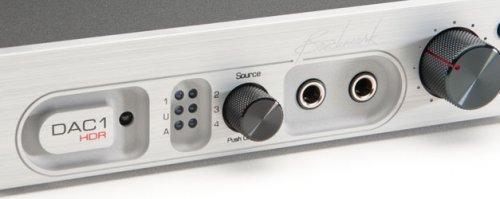Benchmark Media DAC1 HDR
|
Benchmark Media DAC1 HDR |
|
A Clear Winner |
|
|
|
January, 2012 |

Accurate, solid bass, clear. Those are just some of the adjectives I used to describe the HDR in my listening notes. The “HDR” I’m referring to is the Benchmark DAC1 HDR. The DAC1 HDR is the 4th generation DAC1 and is more an evolution of the DAC1 platform than a revolution. It represents Benchmark’s all-out assault on an all-in-one reference-quality, remote controlled stereo preamplifier, full-time 24/192 up-sampling D/A converter, 24/96 USB D/A converter, and headphone amplifier.
The DAC1 HDR’s closest relative is the DAC1 Pre from which it differs by fielding a high dynamic range (HDR) analog custom-motorized Alps volume control (VC) and remote control among other differences. Key among the differences is the choice to eschew using a digital VC in favor of an analog one. I can only speculate as to why they made this decision, what with so many manufacturers using digital VC’s to great effect; Jeff Rowland, Weiss, Bel Canto and Meridian, just to name a few. But I suspect it has something to do with audiophiles’ negative perception of digital VC’s. There is some merit to this sentiment; in the not so distant past, poorly designed digital VC’s dropped bits, thus reducing resolution, as a way of attenuating the volume. To be fair though, analog VC’s themselves have challenges to overcome. Furthermore, some of today’s most innovative digital VC designs are much better than their predecessors. If the successes of the aforementioned manufacturer’s products are any indication, a properly designed digital VC sounds just as good as an analog one. That said, Benchmark’s brand new motorized super duper volume control is said to maintain the dynamic range of the converter and audio output.
There’s a lot of functionality stuffed into the DAC1 chassis, but the svelte chassis manages all the connections well, though the platform is getting a bit cramped. The DAC1 HDR has a single analog input. There is no subwoofer output; however, this isn’t a standard D/A converter feature but since it is also designed to be used as a preamplifier, the omission I believe is justly noted. There are two sets of outputs; one set single-ended, the other balanced (XLR). No less than five digital inputs grace the back of the DAC1 HDR: three coaxial, one USB and one optical. The USB is 24/96kHz capable.
The system
I placed the DAC1 HDR in my system linked to an Aragon 4004 mkII amplifier driving a pair of PBN Audio Pennywise or Ohm Walsh 5 speaker’s. I set the DAC1 HDR output to “variable” as it was doing the D/A conversion and preamping (set it to “fixed” if you’re going to use it exclusively as a DAC) and I was off to the races.
My digital front end consists of a Squeezebox Touch serving up 16/44.1, 24/96 and in some cases 24/192 kHz FLAC, AIFF, or WAV files. Critical listening is done on my living room sofa, however sometimes I take notes while listening casually. More times than I can remember, I’ve heard things in music that I’ve never heard before just causally listening, perusing around the house or working on my computer. When this happens it is truly an “aha” moment. Serious listening began after about 100 hours of burn in.
Listening
From the time I started listening seriously, the DAC1 HDR sounded right. Music flowed in very much the same way it started, which is to say, naturally. I listened to many different types of music from various sources through the DAC1 HDR and it imparted very little of its own character onto the audio signal. Very little however, is still something and the DAC1 HDR errs on the matter of fact side of neutrality. Don’t take this to mean it sounds thin, far from it. While you won’t liken it to tubes, the DAC1 HDR conveys music with fullness, good tone and texture. It eschews excess body, sweetness, and euphonics for a more accurate portrayal of music; think Sarah Jessica Parker as opposed to Kim Kardashian! How’s that for painting a picture.
The DAC1 HDR was dead silent. There was no hiss or noise from the speakers, even at full volume. The high dynamic range VC paid dividends during late night listening sessions where levels were low—music flowed with fullness and body. It presented a black background for which nuances and tonal subtleties live, meander and track along with the flow of music. D/A converters lacking in resolution and transparency can blur these fine details or cloud them altogether. The DAC1 HDR’s strength in this area is highlighted on the track “Chacarera,” from Esperanza Spalding’s Chamber Music Society album [Concord]. The track has great textures, wide dynamic swings, and rhythmically challenging musical passages. The DAC1 HDR was able to demarcate the individual layers of the track and faithfully reproduce the full scale of micro and macro dynamics without coming apart at the seams.
 I went on to play several Kayne West tracks off hisMy Beautiful Dark Twisted Fantasy [Rocka Fella Records] album to see how the DAC HDR handled bass, dynamics and timing. Throughout West’s album, he serves up deep bass lines, synthesizers and beats that make you want to get up and dance. Bass came through the DAC1 HDR with apt authority and slam, but it wasn’t one-notey or overblown.
I went on to play several Kayne West tracks off hisMy Beautiful Dark Twisted Fantasy [Rocka Fella Records] album to see how the DAC HDR handled bass, dynamics and timing. Throughout West’s album, he serves up deep bass lines, synthesizers and beats that make you want to get up and dance. Bass came through the DAC1 HDR with apt authority and slam, but it wasn’t one-notey or overblown.
For my next musical selection, it’s only fitting that I use one of Benchmark’s own recordings, “Out in Cold,” from Sherlock’s Daughter of the Master’s of Their Day compilation. Tanya Horo sings lead on this track which projects a large, spacious soundstage. The Benchmark didn’t disappoint, it was transparent and threw music in the air everywhere conveying a sense of a large hall. While this track is wonderfully recorded making it sound good though almost any component, the DAC1 HDR distinguished itself from other D/A converters by imparting a greater sense of space than had previously existed. The Master’s of Their Day recordings are superb and are a must hear. Check them out here.
The DAC1 HDR played every track I threw at it with unflinching focus and poise with one caveat. Because of its play-it-straight sonic character, it let low quality MP3’s and bad recordings shine through, grain and all. While playing 128kbps MP3’s, and some dynamically compressed pop CD’s the DAC1 HDR sounded a bit rough around the edges. The DAC1 HDR didn’t dip the music in a euphonic bath nor kill it with sugary sweetness instead it allowed the music to hang themselves, so to speak. This is less a hit against the DAC1 HDR than it is on low quality, poorly recorded music, however, it must be noted because some gear masks and massages this grain away from music, making it more pleasant to listen to albeit with less transparency. One must pick their poison I guess.
Benchmark bills the DAC1 HDR an all-in-one reference-quality stereo pre-amplifier so I wanted to see how well it faired against a proven reference quality pre-amplifier; The Meridian 568 Digital Surround Processor. The 568 is a formidable opponent featuring a 24-bit/88.2/96kHz up-sampling DAC, 48-72 bit DSP’s, Resolution enhancement with FIFO memory based de-jittering and pre-emphasis. The 568 retailed for $6495 and is cut from the same cloth as the legendary Meridian 861; The tagline is: the 568 has “street cred.” When you hear reviewers like me, say things like “state of the art performance,” “expertly engineered,” the Meridian 568 is what I’m referring to.
Playing all the same tracks that I had listened to before plus a few more through the Meridian 568 was a lesson in patience. The two components were more similar than not and it was difficult to pick out differences between them. I had to really listen, and then listen to note the differences. This isn’t surprising since the 568 and the DAC1 HDR have garnered accolades for being neutral, accurate and for getting out of the way of the music, fulfilling their design goals.
I had no way of immediately AB’ing them so I took a lot of notes. Another measure of control I used was to only use music  I was intimately familiar with. One such musician was Rebekka Bakken. Her 2005 album Is That You? [Universal] has been in my heavy rotation for the past six months and is a superb mix of female jazz vocals and myriad instruments ranging from saxophones, to violins, to strings. Going back and reading from my notes, a pattern emerged; the Meridian 568 was consistently better in several areas. It was just a bit more transparent and refined. It also had more presence, which lent to a fuller music presentation. The 568 did a better job of allowing me to hear instruments, subtle nuances, and background vocals in music where they were less palpable through the DAC1 HDR. Both were dead quiet, but the 568 dug deeper into the music. Looking back on the comparison, I’m not surprised the 568 won the day. It is more than 3x more expensive than the DAC1 HDR and Meridian it can be argued, does digital as good as anyone in the industry having created Meridian Lossless Processing (MLP). Meridian knows digital.
I was intimately familiar with. One such musician was Rebekka Bakken. Her 2005 album Is That You? [Universal] has been in my heavy rotation for the past six months and is a superb mix of female jazz vocals and myriad instruments ranging from saxophones, to violins, to strings. Going back and reading from my notes, a pattern emerged; the Meridian 568 was consistently better in several areas. It was just a bit more transparent and refined. It also had more presence, which lent to a fuller music presentation. The 568 did a better job of allowing me to hear instruments, subtle nuances, and background vocals in music where they were less palpable through the DAC1 HDR. Both were dead quiet, but the 568 dug deeper into the music. Looking back on the comparison, I’m not surprised the 568 won the day. It is more than 3x more expensive than the DAC1 HDR and Meridian it can be argued, does digital as good as anyone in the industry having created Meridian Lossless Processing (MLP). Meridian knows digital.
While the Meridian 568 sounded better, the DAC1 HDR pulled ahead in other ways. The DAC1 HDR features a 24/96 USB input making it computer friendly and fully “Now” compliant. Along the same lines it includes a HPA2™ headphone amplifier which can drive two sets of headphones via two 1/4″ headphone jacks on the front panel which is also very “Now”. Lastly, the DAC1 HDR’ analog input is unprocessed; the signal stays in the analog domain, giving audiophiles with analog sources more connection options. The 568 digitizes everything, making it less desirable to the aforementioned audiophiles. While the 568 wins for sound quality the DAC1 HDR wins on versatility. Given my listening habits, the DAC1 HDR fits better as I only have digital sources and I’ve been pining for a good pair of headphones. The DAC1 HDR would be ripe and ready for when that dream becomes a reality.
Conclusion
The Benchmark DAC1 HDR was a stellar performer and I could happily live with it in my system. As far as sound quality is concerned, its performance is darn near flawless. I could see Benchmark coming out with another iteration of the DAC1 HDR, adding another analog input, subwoofer output and 24/192 Asynchronous USB, but that’s dreaming. Here now is the Benchmark DAC1 HDR and it is unapologetically accurate and detailed. That’s not to say it’ll be everyone’s cup of tea—some people no doubt, will prefer a sweeter, lusher presentation. The DAC1 HDR calls a spade a spade. More than all else, it’s sound quality that matters and the Benchmark DAC1 HDR is a clear winner.

![]()
Price: $1895.00
Benchmark Media Systems, Inc.
203 East Hampton Place
Suite 2
Syracuse, NY 13206
Toll-free • 800-262-4675 (800-BNCHMRK)
Phone • 315-437-6300
Fax • 315-437-8119
E-mail: sales@benchmarkmedia.com
http://www.benchmarkmedia.com/
![]()
Don’t forget to bookmark us! (CTRL-SHFT-D)
Stereo Times Masthead
Publisher/Founder
Clement Perry
Editor
Dave Thomas
Senior Editors
Frank Alles, Mike Girardi, Russell Lichter, Terry London, Moreno Mitchell, Paul Szabady, Bill Wells, Mike Wright, and Stephen Yan,
Current Contributors
David Abramson, Tim Barrall, Dave Allison, Ron Cook, Lewis Dardick, John Hoffman, Dan Secula, Don Shaulis, Greg Simmons, Eric Teh, Greg Voth, Richard Willie, Ed Van Winkle, Rob Dockery, Richard Doran, and Daveed Turek
Site Management Clement Perry
Ad Designer: Martin Perry





Be the first to comment on: Benchmark Media DAC1 HDR